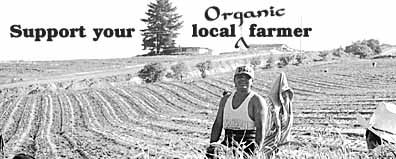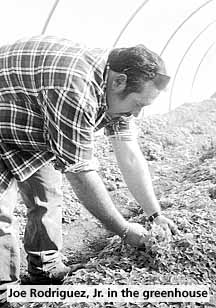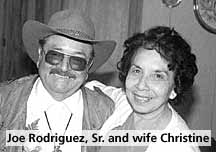![]()
![]()
![]()
![]()
![]()
![]()
![]()

Your food dollar makes the most difference spent with local farms
by Leslie Goldman
![]() his is Harvest EarthFair month in San Diego. What do
we harvest with our food dollar? A healthy society requires a healthy food
supply system. But this system is threatened by lack of local consumer support
and awareness. The "go between" is every "Joe the Farmer,"
the local farmer working in the field on our behalf.
his is Harvest EarthFair month in San Diego. What do
we harvest with our food dollar? A healthy society requires a healthy food
supply system. But this system is threatened by lack of local consumer support
and awareness. The "go between" is every "Joe the Farmer,"
the local farmer working in the field on our behalf.
The following interview is with Rodriguez family
members, Joe Rodriguez Sr., founder of Blue Pacific Wholesale Florists and
Rodriguez Ranch Flowers; Joe Rodriguez, Jr., of JR Organics, with more than
60 organic acres in production; and friend-of-the-farm, Scott Murray, consultant
to Triple R Culinary Herbs, another Rodriguez family business.
LG: What is the food crisis we are facing?
Scott Murray: The trend of support, without our awareness, has been toward a national agriculture, rather than a local bio-diverse agriculture. Niney-five percent of local food is exported, while we import 95 percent of what we consume. Our major supermarkets source less than five percent of local farmers.
The choice is ours: dependence on food from
"somewhere else grown by who?" vs. supporting local farmers who
produce pure, wholesome food distributed direct to the consumer. Supporting
local farming is an issue of national security and personal security.
In 1962, we had 50,000 acres of row crops here.
Now we have only 3,000. Predictions see a population increase of 51 percent
in 20 years, and 57,000 developable acres. But this land is farmland.
More and more of our food is now coming from
Mexico. Fall and Winter '96-'97 imports increased 400 percent. Mexico's
population doubled in the last ten years. At what point will they need to
keep their exports?
Pessimists say we will have no stable food
supply within 20 years. Optimists look toward technology, including chemical
farming and genetic engineering of foods for answers. My solution is building
the local ecosystem. Every time a person shops at a farmers market, joins
a Community Supported Agriculture (CSA) program, or makes sure they are
buying locally grown produce from our favorite store, we are helping the
problem. We can take a positive stand on our food crisis through supporting
the local farmers we have, so younger people will come in and become farmers.
LG: Why organic?
 JR, Jr: When I grew up, we were not aware of pollution, or the
ill-effects of chemical farming. I remember mixing chemicals for the field,
about six ingredients. I wore a respirator. I had to walk away and throw
up.
JR, Jr: When I grew up, we were not aware of pollution, or the
ill-effects of chemical farming. I remember mixing chemicals for the field,
about six ingredients. I wore a respirator. I had to walk away and throw
up.
I met Effie May, one of the local organic growers
at an auction. I visited a number of other farms, and discovered it was
practical to go in this direction.
Amado, my grandfather, was a believer in chicken
fertilizer. The jump to organic was not a big one. Keeping the compost going
is a large financial task; yet building the soil is the key to organic farming.
One of the first sights that greet the visitor to the Rodriguez Ranch are
large compost piles, the answer to remineralizing the soil. You can go out
and buy a few bags of chemical fertilizer and see results. The first two
years are great. Then, the soil will not grow quality food no matter how
much chemicals you give it. The soil becomes addicted to these chemicals.
You can spend $100 the organic way and not
see results as fast, but in the long term it's important. Mexico is producing
more organic food. But the techniques that they are primarily practicing
using chemicals can't feed their soil. By the year 2000, Mexico will have
burned up much of their soil.
LG: How are the farmers markets working for you?
JR, Jr: The farmers markets were created so that farmers could grow and sell their food without a broker, without selling wholesale. We were involved in 1979, in some of the first ones. I steered the family toward organic farming in 1984. We entered the farmers markets about 1991 with our organic produce. Our family does seven markets a week.
JR, Sr: A large part of our income came from the flower industry, and still does. We often wait a month or more to receive payments. The farmers markets mean immediate cash flow.
Once, our organic produce earned 40 percent
of our income. Now its down to 10 percent. The number of farmers markets
have grown, but not the number of customers.

Once, our best market brought in $3,000 to
$5,000; now $2,000-$3,000. Our San Diego El Cajon Blvd. Sunday market brought
in $1,000; now $300.. The organic industry has grown, but operation costs
go up, and profits have gone down. Competition is strong.
In June '96, we had a $20,000 lettuce crop
destruction due to a freak June '96 hailstorm, and a $200,000 loss of perennial
flowers due to fire in October '96.
Challenge is always coming at you in farming.
I thrive on challenge. Each generation goes its own way, but hopefully stays
on the trail that has been made. My grandfather Joe lost everything he had
in Buena Park in a freeze. My father came here and mainly grew produce.
I turned the family toward flower growing. That was where the money was.
Joe Jr. started us in organic produce.
JR, Jr: What we do changes every five to seven years. We are constantly adjusting. I've been farming for 20 years now and see this. Our latest focus is providing high quality organic culinary herbs our Triple R label.
We can deal with Mother Nature and what she
sends us. She will send us some good years. We do not give up.
As farmers, we pay attention to what we have
to do to protect the next generation. We all face the need for more consumer
education. Organic farmers are growing good food faster than new consumers
have arrived. We dump what we do not sell. This hurts. We need people to
support us and we will still be here.
![]()
Leslie Goldman is a friend of the farm, contact
him at: The Enchanted Garden Club-Friend of the Farm/Happiness is Organic
campaign, (619)582-9669